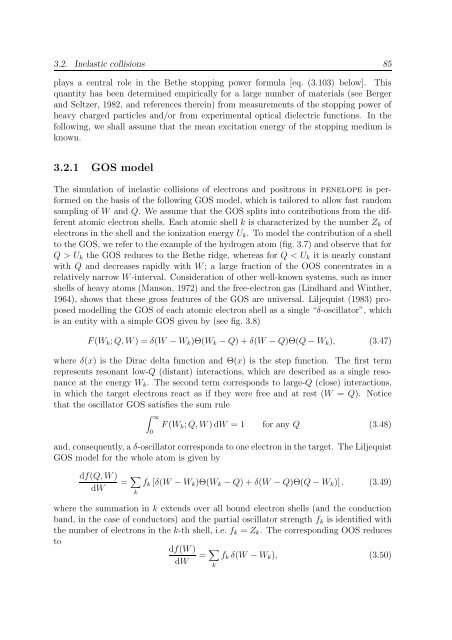PENELOPE 2003 - OECD Nuclear Energy Agency
PENELOPE 2003 - OECD Nuclear Energy Agency
PENELOPE 2003 - OECD Nuclear Energy Agency
Create successful ePaper yourself
Turn your PDF publications into a flip-book with our unique Google optimized e-Paper software.
3.2. Inelastic collisions 85<br />
plays a central role in the Bethe stopping power formula [eq. (3.103) below]. This<br />
quantity has been determined empirically for a large number of materials (see Berger<br />
and Seltzer, 1982, and references therein) from measurements of the stopping power of<br />
heavy charged particles and/or from experimental optical dielectric functions. In the<br />
following, we shall assume that the mean excitation energy of the stopping medium is<br />
known.<br />
3.2.1 GOS model<br />
The simulation of inelastic collisions of electrons and positrons in penelope is performed<br />
on the basis of the following GOS model, which is tailored to allow fast random<br />
sampling of W and Q. We assume that the GOS splits into contributions from the different<br />
atomic electron shells. Each atomic shell k is characterized by the number Z k of<br />
electrons in the shell and the ionization energy U k . To model the contribution of a shell<br />
to the GOS, we refer to the example of the hydrogen atom (fig. 3.7) and observe that for<br />
Q > U k the GOS reduces to the Bethe ridge, whereas for Q < U k it is nearly constant<br />
with Q and decreases rapidly with W ; a large fraction of the OOS concentrates in a<br />
relatively narrow W -interval. Consideration of other well-known systems, such as inner<br />
shells of heavy atoms (Manson, 1972) and the free-electron gas (Lindhard and Winther,<br />
1964), shows that these gross features of the GOS are universal. Liljequist (1983) proposed<br />
modelling the GOS of each atomic electron shell as a single “δ-oscillator”, which<br />
is an entity with a simple GOS given by (see fig. 3.8)<br />
F (W k ; Q, W ) = δ(W − W k )Θ(W k − Q) + δ(W − Q)Θ(Q − W k ), (3.47)<br />
where δ(x) is the Dirac delta function and Θ(x) is the step function. The first term<br />
represents resonant low-Q (distant) interactions, which are described as a single resonance<br />
at the energy W k . The second term corresponds to large-Q (close) interactions,<br />
in which the target electrons react as if they were free and at rest (W = Q). Notice<br />
that the oscillator GOS satisfies the sum rule<br />
∫ ∞<br />
F (W k ; Q, W ) dW = 1 for any Q (3.48)<br />
0<br />
and, consequently, a δ-oscillator corresponds to one electron in the target. The Liljequist<br />
GOS model for the whole atom is given by<br />
df(Q, W )<br />
dW<br />
= ∑ k<br />
f k [δ(W − W k )Θ(W k − Q) + δ(W − Q)Θ(Q − W k )] . (3.49)<br />
where the summation in k extends over all bound electron shells (and the conduction<br />
band, in the case of conductors) and the partial oscillator strength f k is identified with<br />
the number of electrons in the k-th shell, i.e. f k = Z k . The corresponding OOS reduces<br />
to<br />
df(W )<br />
dW<br />
= ∑ f k δ(W − W k ), (3.50)<br />
k
















